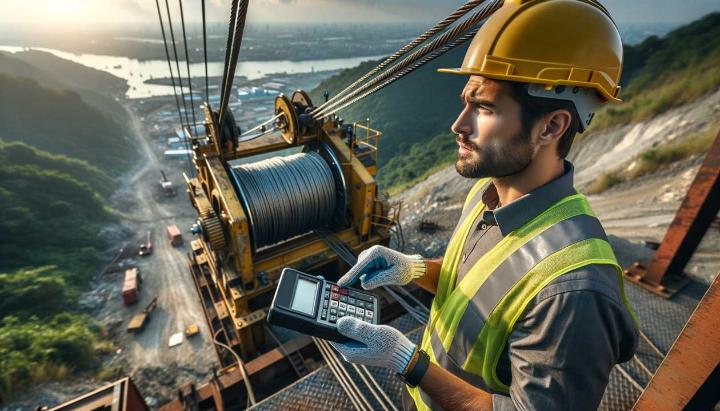Imagine a world without wire pulling ropes and winch systems. Skyscrapers would remain unfinished, mines would struggle to extract precious resources, and off-road enthusiasts would be left stranded in the mud. These unsung heroes of industry are the backbone of countless operations, silently powering progress across the globe.
From the bustling construction sites of Sydney to the rugged mining operations in the Outback, wire pulling ropes and winch systems play a crucial role in keeping Australia moving forward. But their applications extend far beyond our shores, touching industries as diverse as forestry, marine operations, and even aerospace.
In this blog post, we'll explore the essential uses of wire pulling ropes and winch systems, uncovering how these versatile tools are revolutionising efficiency and safety across various sectors. Whether you're a seasoned professional or simply curious about the hidden workings of modern industry, you're about to discover why these humble ropes and winches are the unsung heroes of our technological age.
So, buckle up, mate! We're about to embark on a journey that will change the way you look at the world around you - one rope at a time.
Wire Pulling Ropes: Versatile Tools for Pulling and Lifting
Have you ever wondered how those massive cables get threaded through underground conduits or how heavy machinery is moved in industrial settings? The answer lies in the ingenious world of wire pulling ropes. These unsung heroes of construction, mining, and forestry are the backbone of many operations, quietly doing the heavy lifting - quite literally!
As someone who's spent years in the construction industry, I've seen firsthand how wire pulling ropes can turn seemingly impossible tasks into manageable ones. Let me take you on a journey through the versatile applications of these indispensable tools.
Types of Wire Rope Pullers and Their Applications
Wire rope pullers come in two main flavours: manual and powered. Each has its own set of strengths, suited to different scenarios.
- Manual wire rope pullers are perfect for smaller jobs or tight spaces. They're lightweight, portable, and don't require any external power source. I remember using one to help a mate install solar panels on his roof - it made lifting those heavy panels a breeze!
- Powered wire rope pullers are the heavy hitters. These bad boys can handle massive loads and are often used in industrial settings. They're a godsend when you're dealing with tonnes of equipment or materials.

Choosing the Right Cable Puller for Your Project
Selecting the appropriate wire rope puller can make or break your project. Here are some key factors to consider:
- Pulling force - This is the maximum load the puller can handle. Always choose a puller with a capacity that exceeds your heaviest anticipated load.
- Rope capacity - Consider the length and diameter of the rope you'll need. Longer ropes allow for more flexibility, but remember that thicker ropes are generally stronger.
- Portability - If you're working in various locations, a lightweight, compact puller might be your best bet.
When I'm sizing up a job, I always ask myself: "What's the heaviest thing I need to move, and how far does it need to go?" This simple question has saved me from many headaches down the line.
Remember, whether you're threading cables through conduits in a high-rise construction site, hoisting materials in a bustling mine, or clearing fallen trees in a dense forest, there's a wire pulling rope designed to make your job easier. So next time you're faced with a heavy lifting challenge, don't break your back - reach for a wire rope puller instead!
Wire Rope Pulling Winch Systems: Harnessing Mechanical Advantage
Have you ever marvelled at how a small winch can effortlessly lift a massive load? The secret lies in the fascinating world of mechanical advantage. As someone who's spent years working with wire rope pulling systems, I can tell you that understanding this concept is crucial for anyone in the industry.
Understanding Mechanical Advantage in Pulley Systems
Imagine you're trying to lift a heavy box. It's a struggle, right? Now, picture using a pulley system. Suddenly, the task becomes much easier. That's mechanical advantage in action. It's the ratio of the force you apply to the force needed to move the load. In simpler terms, it's how much easier a machine makes your work.
In my early days on construction sites, I remember being astounded by how a simple pulley system could turn a backbreaking job into a manageable task. It was like having a team of invisible helpers!

How Winches Utilize Mechanical Advantage
Wire rope pulling winches take this concept to the next level. They combine the mechanical advantage of pulleys with the power of motors to create incredibly efficient lifting and pulling systems. Here's how they work:
- Gear reduction: The motor's power is amplified through a series of gears, increasing torque.
- Drum design: The winch drum's diameter affects the mechanical advantage. A larger diameter requires more force but moves the load faster.
- Multiple rope layers: As rope wraps around the drum, the effective diameter changes, altering the mechanical advantage.
I once worked on a project where we needed to move a 10-tonne piece of machinery. Using a properly sized winch system, we were able to do it with remarkable ease. It was a testament to the power of mechanical advantage in action.
Calculating Mechanical Advantage in Wire Rope Systems
While the concept is simple, calculating the actual mechanical advantage can be complex. It involves factors like friction, rope diameter, and system efficiency. Here's a basic formula to get you started:
Mechanical Advantage = Load Force / Effort Force
Remember, this is a simplified version. Real-world calculations are more complex.
In practice, the actual mechanical advantage is often less than the theoretical due to friction and other inefficiencies. That's why it's crucial to work with experienced professionals when designing and implementing wire rope pulling winch systems.
Understanding mechanical advantage isn't just about impressing your mates at the worksite (though it certainly does that!). It's about working smarter, safer, and more efficiently. Whether you're moving heavy equipment in an industrial setting or recovering a stuck vehicle off-road, harnessing the power of mechanical advantage through wire rope pulling winch systems can make all the difference.
Rope for Pulling Wire is Designed for Optimal Performance
When it comes to wire pulling, not just any old rope will do. The secret to a smooth, efficient pull lies in using a rope specifically designed for the job. As someone who's spent years in the trenches (sometimes literally) of electrical installations, I can tell you that the right rope can make all the difference between a job well done and a frustrating day at work.
Types of Wire Pulling Ropes for Different Applications
Let's dive into the world of wire pulling ropes and explore the options available for various scenarios:
- Nylon ropes are the workhorses of heavy-duty wire pulling. Their high strength-to-weight ratio makes them perfect for those challenging pulls where you need both power and flexibility.
- Polypropylene ropes are your go-to for lighter jobs. They're cost-effective and work well for residential or small commercial projects where the loads aren't as demanding.
- Wire ropes come into play when you're dealing with extreme weights or harsh environments. They're the tough guys of the wire pulling world, capable of handling massive loads in industrial settings.
I remember a particularly tricky job where we had to pull cables through a long, winding conduit in an old factory. We started with a polypropylene rope, but it just wasn't cutting it. Switching to a nylon rope made all the difference - the pull went smoothly, and we finished the job in record time.

Key Features of High-Performance Wire Pulling Ropes
What makes a wire pulling rope truly shine? Let's break down the essential features:
- Low friction is crucial for a smooth pull. The best ropes glide through conduits like a hot knife through butter, reducing the risk of snags and making your job easier.
- High tensile strength ensures your rope can handle the load without breaking. There's nothing worse than a rope snapping mid-pull - trust me, I've been there!
- Abrasion resistance is vital for longevity. A good wire pulling rope should be able to withstand repeated use in rough conduits without showing significant wear.
- Flexibility allows the rope to navigate tight bends and corners in complex conduit systems. The more flexible the rope, the easier it is to work with in challenging layouts.
When selecting a wire pulling rope, consider the specific requirements of your project. Are you dealing with a long run that requires a low-friction rope? Or perhaps you need a high-strength option for a heavy load? Matching the rope's features to your needs will set you up for success.
Pro tip: Always check the rope's specifications against the expected load and conduit conditions. It's better to err on the side of caution and choose a rope with higher capacity than you think you'll need.
Remember, investing in a high-quality wire pulling rope isn't just about making your current job easier - it's about ensuring consistency and efficiency across all your projects. So next time you're gearing up for a wire pull, take a moment to consider your rope choice. Your future self (and your back) will thank you!
Essential Safety Precautions for Wire Pulling Ropes and Winches
When it comes to wire pulling ropes and winches, safety isn't just a buzzword—it's a lifesaver. As someone who's spent years in the trenches of construction and industrial work, I've seen firsthand how proper safety measures can mean the difference between a smooth operation and a costly disaster. Let's dive into the critical safety precautions you need to know to keep yourself and your team out of harm's way.
Understanding Winch Safety Factors and Risk Assessment
Before you even think about firing up that winch, you need to understand its safety factors. Wire rope winches typically have a safety factor of 3:1, which means they're designed to handle three times their rated capacity. But don't let that lull you into a false sense of security. Always operate within the manufacturer's specified limits.
- Conduct a thorough risk assessment: Before each job, take a step back and evaluate potential hazards. Are there overhead power lines? Unstable ground? Other workers in the vicinity? Identifying risks beforehand can prevent accidents later.
- Check your equipment: Inspect your wire pulling ropes and winches for signs of wear or damage. Look for frayed wires, kinks, or rust on cables, and ensure all connections are secure.
- Know your load: Always calculate the weight of your load and compare it to the winch's capacity. Remember, it's not just about weight—consider factors like friction and incline that could affect the pull.

Proper Winch Operation Techniques to Prevent Accidents
Now that you've assessed the risks, it's time to operate that winch safely. Here are some crucial techniques to keep in mind:
- Maintain minimum wraps: Always keep at least 8 wraps of cable around the winch drum. This ensures proper grip and prevents the cable from slipping under load.
- Use D-shackles for secure connections: When connecting your winch to an anchor point, D-shackles are your best friends. They provide a secure, load-rated connection that won't let you down.
- Wear appropriate PPE: Safety gloves are non-negotiable when handling wire ropes. They protect your hands from cuts and burns. Don't forget about eye protection and a hard hat, too.
- Clear the area: Before you start pulling, make sure everyone is clear of the rope's path. A snapped cable can whip back with incredible force, causing serious injury.
I once witnessed a near-miss where a worker stood too close to a tensioned cable. When it suddenly released, it missed him by inches. That's a wake-up call you don't want to experience firsthand.
Remember: Different rope materials require different care. Synthetic winch ropes and steel cables have unique maintenance needs. Always follow the manufacturer's guidelines for your specific equipment.
By following these safety precautions and proper operation techniques, you're not just protecting yourself—you're ensuring the safety of everyone on site. Remember, when it comes to wire pulling ropes and winches, there's no such thing as being too careful. Stay safe out there, mates!
Get in Touch with Us for Your Custom Rope Needs
If you're involved in construction, mining, forestry, or any industry requiring heavy lifting, understanding the various uses of wire pulling ropes and winch systems is crucial. These tools, from rope for pulling wire to wire rope pulling winch systems, offer mechanical advantages that make daunting tasks manageable. Made from durable materials to ensure optimal performance, safety, and efficiency, these ropes are indispensable. Always inspect your equipment and prioritise safety with proper PPE and adherence to guidelines. For any customised rope solutions, please fill in the inquiry form above. Trust iRopes for high-quality, tailored rope solutions to meet your industry-specific needs.